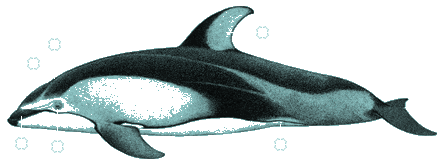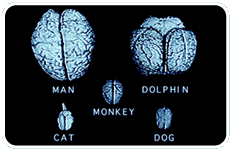|
|
 |
|
This is the page where you can learn about a dolphin from the inside out.
|
 |
|

Teeth
A dolphin's teeth are never used for chewing (dolphins swallow food whole) but they do
help it grab prey. Some scientists also believe that the teeth are spaced in such a way that they help the dolphin analyze
sound waves!
Melon
This is the fatty, rounded section of a dolphin's forehead It is extremely sensitive and is
used for a complex use of echolocation. The melon acts as an acoustical lens to focus sound waves into a beam that is projected
in front of the animal.
Dorsal fin
A dolphin's dorsal fin is mostly composed of cartilage that can be as distinctive
as a human's face and is used by scientists to identify individuals. Dolphins that have dorsal fins (not all do) seem to use
them for stability.
Eyes
Dolphins have elastic lenses on their eyes that expand and contract. This lets the dolphin
be able to see above and below water.They have special glands that shield their eyes from salt water. But because they have
extraordinary hearing their eyesite is poor.
Skin
Like human skin, dolphin skin has many nerve endings, which
explains why tame dolphins like to be stroked. Dolphin skin is also extremely sensitive and easily injured by rough surfaces
and harsh handling. It can be cut by a sharp fingernail, but tends to heal quickly.
Blowhole
The blowhole is a
dolphin's nostrils, they allow it to breathe while swimming at top speed. To breathe while asleep, female dolphins lie on
the water's surface with their blowholes exposed to the air. Males sleep just below the surface and rise to breathe periodically
as a reflex action.
|
 |
|
|
 |
|
|
 |
|
|
 |
 |
 |

Dolphin Story: Are they smart or what?
Dolphin researcher Pieter Arend Folkens tells this story: "Since trash can
be dangerous to dolphins if ingested, some of the animals at Marine World Africa USA were trained to retrieve the trash and
return it to the trainer for a reinforcement reward.
"A trainer would come out onto the floating stage and a dolphin
would perform a tail stand with a piece of trash in its mouth. The trainer would then reward the dolphin with a bit of fish.
"One day the lead trainer went through the routine only to notice that the dolphin kept coming back with
a piece of trash even though the tank appeared clean. The trainer asked a colleague to go below to the engineer's port to
observe what the dolphin was doing when a trainer came out on the float. The trainer came out on the float and sure enough,
the dolphin quickly showed up with a piece of trash and got his reward.
"The scam was revealed! This dolphin had
established a savings account of sorts. He collected all the trash and stuffed it in a bag wedged in a corner of the tank
near the intake of the filtering system. In there was paper, rope, and all sorts of trash. The amazing thing is that when
he went to the bank he did not simply take a piece, rather he would tear a bit off to maximize the return.
"This
behavior is particularly interesting because it shows that the dolphin had a sense of the future and delayed gratification.
He had enough presence to realize that a big piece of trash got the same reward as a small piece, so why not deliver only
small pieces to keep the extra food coming? He in effect had trained the humans."
The brain of the dolphin is
capable of memory and assosiating ideas. It may, someday, be capable of language. Wouldn't that be neat?

|
|
|
|



